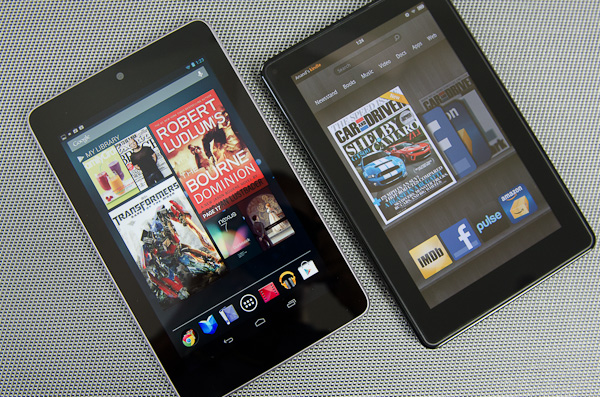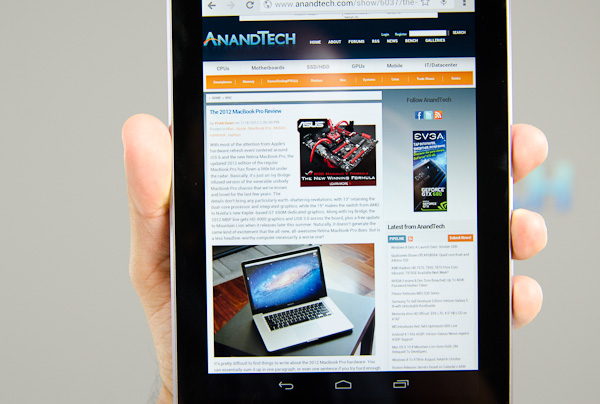The Google Nexus 7 Review
by Anand Lal Shimpi & Brian Klug on July 26, 2012 11:35 AM ESTFinal Words
The Kindle Fire was great because it married decent software with decent hardware, at a reasonable price. Previous attempts at ~7-inch tablets made sacrifices in one or more of those areas. Amazon knew what it was doing and the Kindle Fire apparently sold quite well. The Nexus 7 executes the same formula, but with better components. The OS is miles better than what you get with the Kindle Fire, and as a Nexus device built by ASUS it's likely to be the first in line for major Android OS updates so long as Tegra 3 is up to snuff. The hardware is better as well. OMAP 4 was good for its time, but Tegra 3 is just faster. While the usefulness of those extra cores is debatable, clock speeds are higher and the added cores definitely don't hurt performance.
Finally the price point remains unchanged, at $199 the Nexus 7 is a tablet for those who are on the fence about owning a tablet. If you're able to carry around and use the iPad in lieu of a notebook, its $499 price tag is easily justifiable. If, however, the iPad is just an augment to your computing life then spending $499 becomes a tougher pill to swallow. The Nexus 7 brings that commitment level down considerably. For years Android tablet makers have gone after the iPad with comparable hardware, at a comparable price. While there have been some successes, the market for $499+ Android tablets will likely be cannibalized by Windows RT tablets come late this year. The Nexus 7 takes Android into a space that it's quite comfortable with. Subsidized $199 Android phones sell all of the time, and the Nexus 7 delivers a mini-tablet experience at that same price point.

The screen isn't big enough for everyone, but if you're fine with (or better yet, really want) a 7-inch tablet, the Nexus 7 is great. It's well built, has good hardware and is priced perfectly. The only downside is really the limited (and not expandable) internal storage. The lack of expandable storage keeps the Nexus 7 from winning a higher level accolade, but the rest of the package is enough to earn our bronze Editor's Choice award.
The Nexus 7 isn't just a great Android tablet, it's a great tablet.












118 Comments
View All Comments
Sprchkn - Thursday, July 26, 2012 - link
Except that Flash isn't supported on Jelly Bean... I know, mine arrived yesterday and I tried that. Amazon either needs to release an Android app or move to HTML5.But, I've already cancelled the auto-renewal on my Prime account due to their use of Flash DRM which requires a workaround to install the deprecated HAL package under Gentoo so it's not like I'm married to them. Google actually seems to be the only one that supports both Linux and Android, so I'll just start purchasing my video content from them.
Impulses - Friday, July 27, 2012 - link
Flash works fine on Jelly Bean under Firefox and other browsers, just need to side load it.RamarC - Thursday, July 26, 2012 - link
will allow usb tthumb drive/sd cards to be used with the Nexus 7.WolvenSpectre - Thursday, November 8, 2012 - link
The problem is that it doesn't give you any write capability.Pino - Thursday, July 26, 2012 - link
"213 pixels per inch in a 7 inch display is unique for an Android tablet"Lenovo´s S2007 tablet has such a display and was launched way before the Nexus 7:
http://appserver.lenovo.com.cn/Lenovo_lepadSeries_...
eaanders@cox.net - Thursday, July 26, 2012 - link
The primary advantage of the Nexus 7 is price. If a tablet is so small you need to zoom, the sweet spot is the Galaxy Note. It's half the weight of the 7, fits in your shirt pocket, and combines the features of a phone, a camera, and a small tablet in one unit with the possibility of adding an additional 32 Gb of storage. The Note 2 will be even faster.My netbook will be replaced by a Windows 8 hybrid eventually for full computing power. This and the Galaxy Note are all I will need to do everything mobile.
Sprchkn - Thursday, July 26, 2012 - link
I think it depends on what you're using it for. I bought the Nexus 7 so that I can leave my phone docked up to my stereo and then look up recipes, check email, etc. while I'm in the kitchen cooking. The speakers are a bit weak, but it will probably also see some duty playing movies, again, while I'm cooking or perhaps when I'm on my treadmill. The missing storage hasn't been a problem for me with the way I use my phone and I always have my iPod available for music duty. Besides, for whatever reason, I've always had trouble with the micro SDs and corruption when copying large amounts of data onto them - so I'm actually relieved that Google Play means I no longer have to deal with that.MadMan007 - Thursday, July 26, 2012 - link
An unlocked Galaxy Note is over twice as expensive as the Nexus 7. It's only fair to compare unsubsidized vs unsubsidized pricing. Everyone's needs and wants are different, but the 'if you're going to zoom anyway' point is valid if one were going to get a subsidized phone anyway and can deal with the size of the Note as a phone.hackbod - Thursday, July 26, 2012 - link
Great stuff on the NAND performance, as well as the commentary on the screen configuration. Your reviews are consistently the most detailed and technically accurate I see.One thing that would be interesting to do is NAND performance comparisons with the 16GB model. I believe this uses a different NAND controller, so you should see some different interesting behavior. And since the 16GB model is likely more popular than the 8GB one, this would be relevant to many people.
risa2000 - Friday, July 27, 2012 - link
I would like to see similar tests (flash throughput) done also with smartphones. There has been rumors that there are some significant difference between some (e.g. iPhone and some Androids) and it would be interesting to know also for new WP devices.